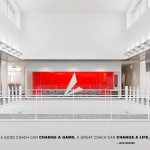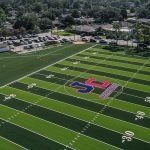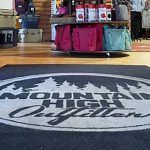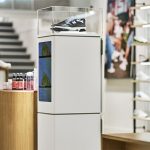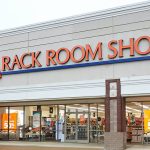While Outdoor Retailer has always showcased traditional outdoor and trail running footwear product at both the Summer Market and Winter Market, it is now quite evident that the venue has become the next stop-for other more traditional athletic brands and retailers-in search of a meeting place as the WSA show continues to lose it athletic and outdoor constituency.
The show has extended its reach beyond those brands that make trail running footwear-to become the de facto running specialty venue for brands and running specialty retailers. The date of the Winter Market show lines up perfectly for many seeking to get a solid handle on new product for Fall 2010 — particularly in apparel. The surprise this year was the presence of more brands touting toning/shaping/wellness footwear, a domain once populated solely by MBT. But this year the footwear retail market finds itself in a bit of a mini-explosion of excitement as Skechers and Reebok post meteoric growth in their respective categories.
Running, whether jogging to stay in shape or tackling marathons or triathlons, is clearly an associated activity for outdoor enthusiasts to pursue alongside climbing, hiking or paddling, especially as the U.S. continues to experience what many are calling the second running boom for the country. Also, excitement is growing over the emerging natural running category and many footwear vendors came out with new models for the show.
The crossover appeal for running has many revered outdoor brands like Salomon, Vasque and Merrell looking to the traditional running specialty market for penetration and acceptance. Traditional running brands like Brooks, Saucony, Asics and others are looking for new opportunities in traditional outdoor stores that are slowly but surely starting to understand they have been sending loyal customers down the street to buy product they were more than capable of selling. And running specialty stores realize they have been sending loyal customers down the street to purchase lifestyle footwear and apparel that could be easy add-on sales for most any outdoor store. A quick look at Curt Munson’s Playmakers store in Okemos, MI, finds a hybrid venue that has brands like Asics and Saucony splitting lead billing with The North Face, Keen, and Smartwool.
But it may be the arrival of so much more in the toning/shaping/wellness category that had booths popping up on the footwear side of the show.
While Avia featured its new Avi-Quest running technology, the big emphasis was on the launch of its Avi-Motion toning footwear. The collection has already received a “phenomenal” reception at retailers such as Kohl’s, JC Penney, and Midwest shoe chain Trade Home since being introduced in December, according to Ike Alvear, executive director of performance footwear at Avia.
“We’re selling boatloads,” said Alvear. The shoes comes in two models, I-Tone and I-Shape, for Spring 2010 and more colors and athletic features are being introduced in Fall 2010. The shoe’s Archrocker design enhances the users rocking motion from heel to toe in the gait cycle. Its Shear Cantilever System accelerates the heel area's ability to rebound to its natural state in time for the next heel strike.
But Alvear said the shoe’s comfort is helping it win shelf space at the $100 conditioning shoe level.
“It’s been a game changer for the brand,” said Alvear. Other toning vendors included Skechers and MBT.
Skechers, at its second Outdoor Retailer show, tripled the size of its booth and now features a dedicated section for Shape Ups. In addition, booth staff were handing out drawstring bags adorned with the Shapes Up logo.
MBT, the leader in the toning footwear market with retail prices that start around $130 and run over $300 for more stylish models, continues to work to improve styling.
“The look has been the reason not to buy but I think we have gone a long way in styling,” said Molly Heaney, MBT’s director of marketing. MBT entered the boot category last fall and continues to add richer leathers to much of its line and more athletic-features to its sportier shoes. A new athletic model for Fall 2010, for instance, is 20% lighter than past athletic models. In 2009, Gore-Tex was added to select styles for added warmth and that program is being expanded in 2010.
Heaney also said MBT saw solid growth in 2009 despite the bigger vendors such as Skechers and Reebok entering the category, and welcomes the competition.
“We’re seeing it all drawing awareness to and driving relevance to the category, but we feel we’ll always be the leader in innovation,” explained Heaney. “We’re doing very well and are looking for a strong 2010.”
Clearly, the added attention to the category will see all boats rise here over the next few years. It may depend on how many boats get into the water.
Looking at running-specific product, Brooks Sports showcased Brooks DNA, its new innovative cushioning system. The technology automatically and physically adapts with each foot strike to the ever-changing amount of force placed on the foot during the run.
“We’ve been engineering this material for about three years,” noted Jim Weber, president and CEO of Brooks. “It’s actually a liquid and engineered to perform at the molecular level like millions of 'nanosprings.' It’s soft, but will adapt to specific forces in a non-linear way. So if you’re a 300-pound guy on landing it will come back to where you need it and if you’re a 150 pound person on landing it comes back to the same space. It adapts to different levels of force. It’s very responsive.”
The Brooks DNA technology promises to provide 30% better cushioning than standard gel or EVA materials at baseline impact levels — and even better at higher impacts. It also claims to provide twice as much energy return with maximum force applied. The technology, available in the Brooks Glycerin 8, will eventually be rolled out across the Brooks line.
“It’s the first patent Brooks has applied for in 15 years,” said Weber. “We feel that strongly about it.”
Brooks also launched a new Beast motion control shoe that’s much sleeker than past models. Weber also predicted the Ghost 3 neutral shoe “to be a home run for us,” especially considering that the Ghost 2 had earned numerous industry awards from the running community.
A new line of soft-shell jackets is expected to revive its apparel business.
A new line of soft-shell jackets is expected to revive its apparel business.
Weber noted that Brooks managed to grow last year due to strength on the footwear side.
“We would have liked to have grown more but we had some challenges with our apparel,” Weber noted. “We were happy with our footwear outcome. But the customer is there and the running lifestyle is strong. So we’re investing aggressively and we expect to grow in the double digits this year.”
Saucony debuted its Amp Pro compression apparel collection that combines compression materials with Celliant, a technical fiber. Andrew Conley, product line manager for apparel, said Amp Pro, which will reach stores in July 2010, is designed to improve blood circulation, and increase oxygenated blood levels not only to improve performance but promote healing and reduce recovery time. As such, the line includes items for training but also a recovery long sleeve and tight as well as a recovery suit designed for recovery during sleeping. “A primary reason people wake up during sleep is a change in body temperature so this controls that,” explained Conley. “Athletes want every edge they can get.”
Saucony also introduced the Kinvara, its first barefoot running or minimalist shoe. Kinvara is a neutral shoe that weighs in at 7.7 oz for men, according to Nikhil Jain, technical running product line manager at Saucony. Midsole center heights are only 18 millimeters to provide a very low heel to complement a 14-millimeter forefoot. “It also uses a high abrasion EVA that sets up a smooth ride,” noted Jain. The $90 shoe is available in May 2010.
New Balance came out with the New Balance 101 trail running shoe, an update to the successful New Balance 100, in the barefoot running style. On the apparel side, one particular innovation for Fall 2010 is the 360 Degree Jacket, the only jacket to earn the 360 Degree Enhanced Visibility Code for night running. Features include 3M Scotchlite reflective taping, a Hi-Viz mesh-lined back vent, and Hi-Viz mesh-lined sleeves.
K-Swiss showcased its Blade-Light cushioning technology in the brand’s first take on barefoot running.
“The Blade-Light becomes a great vehicle to allow us to address that lightweight, minimalistic, ultra-natural running opportunity,” believes Mark Sheehan, director of performance footwear at K-Swiss. The technology represents almost a self-absorbing conditioning system in which a series of ‘blades’ align to the angle of impact, he said. The blades collapse and compress in proportion to the forces applied through the running gait. After impact, the blades return to their original shape and provide a ‘springy’ feel. The blades also provide a high level of traction when splayed due to natural foot flexion. Blade-Light comes in three styles: Run, a 9.3 oz neutral-cushioned training shoe; Race, a 8.9 oz racing shoe ideal for triathlons; and Recover, an 8.9 oz pre-run or post-run shoe featuring a foam footbed to cradle feet and an articulated compression therapy to promote circulation and speedy recovery.
This year K-Swiss will also continue to build on its Tubes cushioning technology with the addition of Tubes Run 102 featuring full-length cylinders that provide a responsive heel-to-toe transition.
With the numerous technologies introduced over the last two years since it decided to explore the running opportunity, Sheehan considers K-Swiss’ running line complete for the next two years with an update probably timed for the next Summer Olympics. The Tubes collection, launched last fall, enables K-Swiss to address the $75 entry-level price point and he expects the company will be able trim that price point to $70 once production reaches 100,000 units. The brand’s miSoul technology, featuring interchangeable insoles, was designed to be a breakthrough product and “open people’s eyes to show we’ve been a footwear company for 40 plus years so we know how to make shoes and we have a technology nobody else has,“ according to Sheehan.
Introduced in Spring 2009, miSoul now includes four interchangeable insoles: Light 1.0, Cushion 1.0, Stability 1.0 and Orthotic 1.0. While miSoul was designed to legitimize K-Swiss’ line of traditional running shoes, such as the Keahou 2 neutral cushioning model, Sheehan, a former Nike footwear exec, said he was “pleasantly surprised” that strong acceptance of those traditional shoes are helping expand miSoul.
Introduced in Spring 2009, miSoul now includes four interchangeable insoles: Light 1.0, Cushion 1.0, Stability 1.0 and Orthotic 1.0. While miSoul was designed to legitimize K-Swiss’ line of traditional running shoes, such as the Keahou 2 neutral cushioning model, Sheehan, a former Nike footwear exec, said he was “pleasantly surprised” that strong acceptance of those traditional shoes are helping expand miSoul.
Sheehan said K-Swiss is now in over 100 running specialty doors in the U.S. The brand’s aggressive sponsorship of triathletes, and the numerous new technologies-now including Blade-Light-are helping K-Swiss gain traction in the space. “We now have a versatile technology platform that lets people know we’re serious about running,” said Sheehan. “Anybody can bring one series of shoes to the game and they may be gone next year. But when retailers saw our commitment, that just opened their eyes. K-Swiss is going to be a new player in the world of running. It legitimized everything we’ve always said.”

